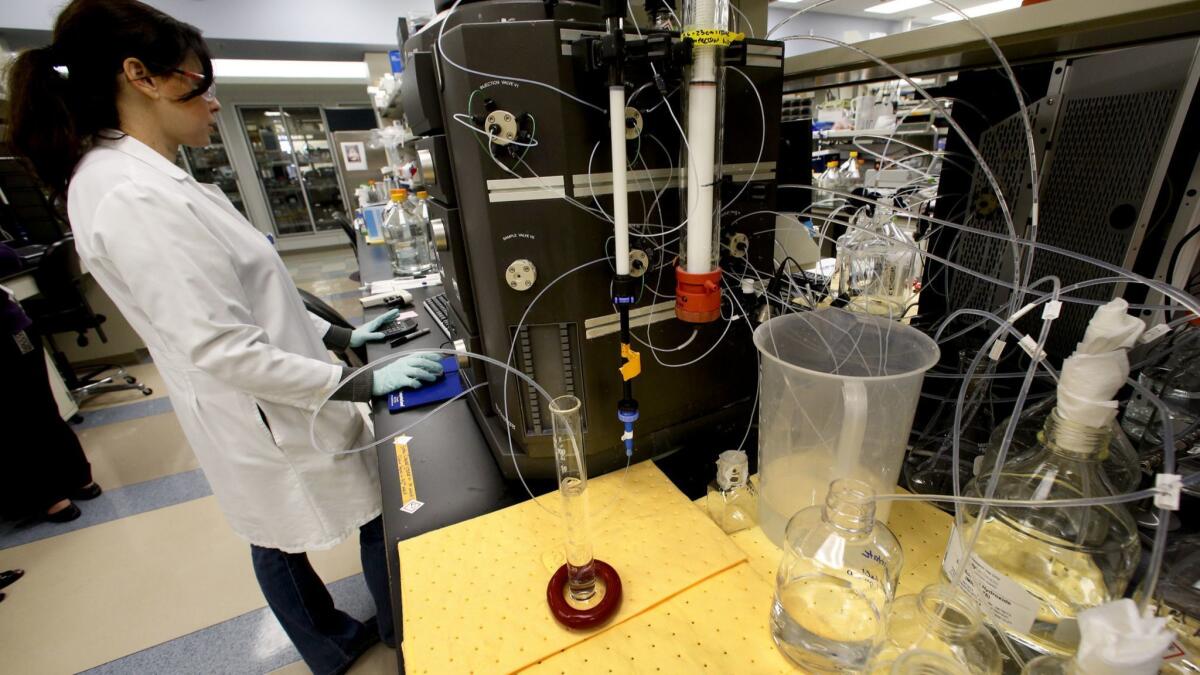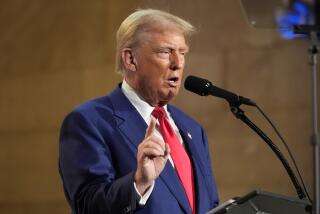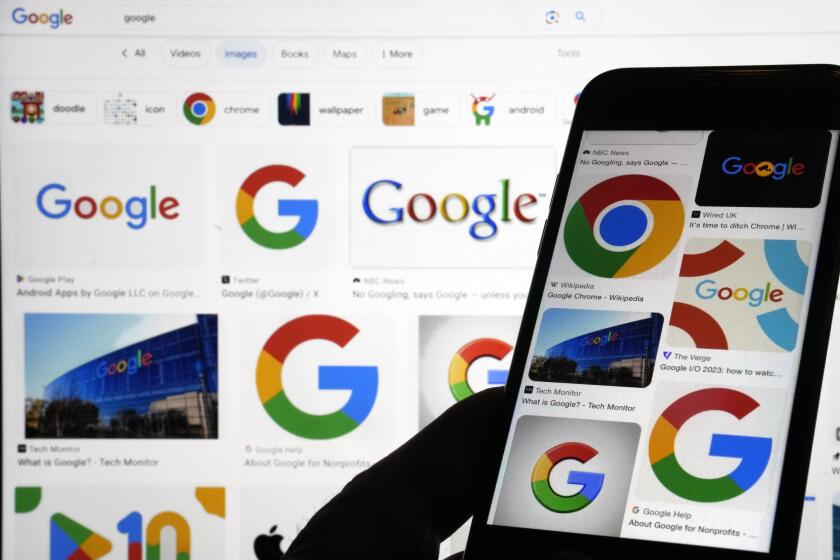Businesses hiked spending after the tax bill, but the U.S. economy still awaits that promised big boost

Reporting from Washington — Southern California biotech giant Amgen Inc. opened its first state-of-the-art factory in Singapore in 2014 and executives were preparing late last year to pick the spot for a second one.
Then they hit the pause button.
Congress was closing in on a sweeping $1.5-trillion Republican tax bill with major benefits for U.S. businesses. If the legislation passed, domestic locations would vault into stronger competition with sites abroad to land a factory that would cost as much as $300 million to build, said David Meline, Amgen’s chief financial officer.
“We were actually considering doing it in December and I said, ‘It looks like tax reform might occur,’ ” he said. “So we held up the decision for a couple of months with the possibility that … the business case in the U.S. might be competitive with other global choices.”
The bill was approved and signed into law by President Trump in the final days of 2017. This spring, Amgen announced it would build its new factory at its West Greenwich, R.I., campus at a cost of about $165 million.
Five months after the tax law went into effect — highlighted by a slash in the corporate rate to 21% from 35% — U.S. companies have ramped up their domestic spending.
A closely watched measure of business capital investment growth in the U.S. jumped to a 9.2% annual rate in the first quarter of the year, the best since 2014, according to the Commerce Department. Kevin Hassett, a top economic advisor to President Trump, boasted this week that “you can see capital spending skyrocketing just as we said it would.”
But many of those spending decisions were made months, if not years, before.
Although surveys show businesses are planning to do more spending, experts said that it’s unclear if the law will produce the big sustained boost to capital investment that its supporters have promised. Add in the potential for a global trade war, which would damp business spending, and it’s going to take a while to determine the tax bill’s effect.
“It’s still premature to conclude anything,” said Mark Zandi, chief economist at Moody’s Analytics. “I do expect to see some pickup in investment, but I don’t think we’re going to get this surge in investment.”
What’s more, stock buybacks among Standard & Poor’s 500 companies hit a record $187.2 billion in the first quarter, a 37% surge, according to a report from Howard Silverblatt, an analyst for S&P Dow Jones indices. Among those companies was Amgen, which repurchased $10 billion in stock this year.
Combined with stock dividend payments over the previous year, money returned to shareholders in S&P 500 companies topped $1 trillion for the first time, Silverblatt said.
That spending reflects one certainty: U.S. businesses have more money because of the tax changes.
A key measure of after-tax corporate profit increased 7.8% in the first quarter — the most in two years, according to the Commerce Department.
Democratic critics of the tax law said buybacks benefit mostly wealthy investors and stock-holding corporate executives while doing little for average Americans.
“The harsh fact is that corporations aren’t using the bulk of their tax savings to boost worker pay or provide additional benefits or hire more workers or buy more equipment,” Senate Democratic Leader Charles E. Schumer (D-N.Y.) said last month.
“They are using the predominance of tax savings on something called stock buybacks. The CEO says: ‘Let’s buy back the stock.’ ” he said. “His shares go up. The shareholders’ shares go up. The American worker is left holding the bag.”
Jamie Dimon, chief executive of JPMorgan Chase & Co, the nation’s largest bank, defended the practice this week.
“I think it’s a tremendous error for people to think there is something wrong with stock buybacks and dividends,” he told reporters on a conference call Tuesday after releasing survey data from the Business Roundtable trade group, which he chairs.
“When a company cannot use its capital, it then gives it back to its shareholders who redeploy it in a higher and better use,” he said.
Buybacks and increased dividend payments don’t fuel economic and job growth as directly as spending on buildings and equipment does. Overall, the economy grew at a 2.2% annual rate in the first three months of the year, well below the 3% or higher pace President Trump and Republicans have promised.
Economists expect growth to nudge over 3% in the second quarter.
The Organization for Economic Cooperation and Development, composed of the 34 most advanced economies, forecast this week that the U.S. economy would grow 2.9% this year and 2.8% next year.
Both estimates are an improvement from 2017’s 2.3% growth. The economic group said stronger business investment boosted by the tax cuts was a reason for the brighter outlook.
Business owners are more optimistic about the economy since Trump’s election in 2016 and surveys show that has translated into increased spending on capital expenditures as the tax changes were proposed last fall and then enacted.
The Republican tax bill, which passed Congress with no Democratic votes, was focused on tax cuts for businesses.
The corporate tax rate, which was the highest among developed nations, was permanently slashed so it’s now below the average of those countries. The move was designed to make investing in the U.S. competitive with doing so abroad.
Going forward, Amgen’s Meline estimated the Thousand Oaks company would make 75% of its capital expenditures in the U.S., up from 50% before the tax changes.
“We can see a material rebalance of our investment activities in favor of the U.S as a direct consequence of the improved competitiveness of tax reform,” he said.
Businesses also will get a short-term break on purchases of equipment. Instead of deducting the costs over several years, businesses for the next five years will be able to deduct the costs immediately.
So-called pass-through businesses, which file through the individual code, also got several breaks that reduce how much in taxes many of them pay. Those businesses cover a wide range, from mom-and-pop operations and privately held manufacturers to large partnerships such as law firms and hedge funds.
Combined with an improving economy and still-low interest rates, “the stars are all in the right alignment” for more spending on capital expenditures, said William C. Dunkelberg, chief economist at the National Federation of Independent Business, which represents many pass-through businesses.
The most recent survey from the group, which represents small businesses, found 61% said in April that they had made capital expenditures in the previous six months. That was up 3 percentage points from the prior month but down from 66% in February, the highest since the Great Recession.
Nearly 3 in 10 said they planned a capital expenditure in the next three to six months.
A recent survey by the National Assn. of Manufacturers found 86% planned to increase investments because of tax reform.
“You’ll see that play out over the next several years,” said Christopher Netram, the trade group’s vice president of tax and domestic economic policy. “It’s starting now, but capital investment is a process for companies small and large.”
But how much that spending will increase remains a major question. A survey in April by the National Assn. for Business Economics found that 65% of respondents indicated the tax law changes didn’t cause their firms to change hiring or investment plans.
Business spending on investments, such as factories and equipment, increased at an annual rate of 9.2% in the first quarter, up from 6.8% in the fourth quarter of last year.
But those investment figures historically “bounce all over the place” because spending decisions can hinge on volatile factors such as oil prices and interest rates, said Alan Auerbach, director of UC Berkeley’s Robert D. Burch Center for Tax Policy and Public Finance.
It will take at least a year’s worth of data to get an accurate read of the effects of the tax changes, Auerbach said.
“It’s not going to change life as we know it, but it’s a positive development,” he said of the tax bill.
But other changes in the economy mean the environment for more spending is “only somewhat advantageous,” said Moody’s Zandi.
While tax cuts have made the cost of capital lower, rising interest rates in recent months are offsetting some of that, he said.
And looming over many businesses is the potential for a trade war after Trump imposed or threatened tariffs on imports of key products, such as steel and aluminum, from China, Canada and Europe while also renegotiating the North American Free Trade Agreement.
“Until you get some clarity on that, I’m not sure you’re going to plunk down a lot of cash and make an investment with it,” Zandi said. “This script is still being written.”
Twitter: @JimPuzzanghera
More to Read
Inside the business of entertainment
The Wide Shot brings you news, analysis and insights on everything from streaming wars to production — and what it all means for the future.
You may occasionally receive promotional content from the Los Angeles Times.











